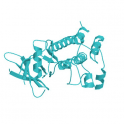
- Remove this product from my favorite's list.
- Add this product to my list of favorites.
Products
Newsletter
 |  |  |  |  |  |

Background: The proviral insertion site in Moloney murine leukemia virus, or PIM proteins are a family composed of three isoforms (PIM-1, PIM-2 and PIM-3). The proteins belong to the group of calcium/calmodulin-regulated kinases (CAMK) and are constitutively active expressed and regulated primarily by transcription and stability through pathways that are controlled by Janus kinase/Signal transducer and activator of transcription, JAK/STAT, transcription factors. PIM kinases are mainly responsible for cell cycle regulation, antiapoptotic activity and the homing and migration of receptor tyrosine kinases mediated via the JAK/STAT pathway. The PIM kinases are highly homologous to each other: at the amino-acid level, PIM1 and PIM3 are 71% identical, whereas PIM1 and PIM2 share 61% homology. Increased PIM2 kinase levels have been detected in AML patients and during the progression of B-cell derived malignancies. Furthermore, the spread of prostate cancer cells, has been found to be associated with elevated PIM2 expression.
Recombinant Human protein kinase PIM-2, amino acids M1-P311, protein kinase domain, recombinant and active protein, N-terminally fused to GST-HIS6-Thrombin cleavage site
Theoretical MW : 64.096 kDa (fusion proteins)
Expression system: Baculovirus infected Sf9 cells
Purification: One-step affinity purification using GSH-agarose
Storage buffer: 50 mM Tris-HCl, pH 8.0; 100 mM NaCl, 5 mM DTT, 4 mM reduced glutathione, 20% glycerol
Protein concentration: 0.216 mg/ml (Bradford method using BSA as standard protein)
Method for determination of Km value & specific activity: Filter binding assay MAPH membrane
Specific activity : 35,000 pmol/mg min
Entrez Gene ID: 11040
UniProtKB: Q9P1W9
Ordering information: shipped on dry ice
Blanco-Aparicio C1, Carnero A. (2013) “Pim kinases in cancer: diagnostic, prognostic and treatment opportunities.” Biochem Pharmacol. ;85(5):629-43.
Brault L, Gasser C, Bracher F, Huber K, Knapp S, Schwaller J.„PIM serine/threonine kinases in the pathogenesis and therapy of hematologic malignancies and solid cancers.” Haematologica. 95(6):1004-15.
White E.(2003) “The pims and outs of survival signaling: role for the Pim-2 protein kinase in the suppression of apoptosis by cytokines.” Genes Dev.;17(15):1813-6
Follow us